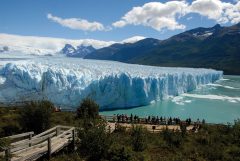Where to Go When - Weather in Argentina
Wondering when is the best time of year to go to Argentina? Explore our in-depth guide to the weather in Argentina by seasons, as well as wildlife spectacles and cultural events throughout the year.
December - February
These are the summer months, which see the highest temperatures across the country. This is the busiest time for visitors in many regions of the country, when many Latin Americans take their holidays. In some areas the soaring temperatures are uncomfortable and accompanied by high humidity and steamy downpours: these include Buenos Aires, Cordoba and the Central Sierras, Salta and the northwest Andes. This is a good time to visit Patagonia as the weather will be at its clearest and warmest, optimal conditions for outdoor activities such as hiking or horse-riding, though you’ll likely encounter many other visitors on the trails. Following plenty of rainfall, the dramatic Iguazú Falls are full to bursting.
28°C Average max daytime temperature
17°C Average min nighttime temperature
8 days per season rainfall
Moderate humidity

March - May
Across the country, autumnal foliage sets the landscapes ablaze with fiery reds and golds; Patagonia, the pampas and Mendoza are particularly scenic this time of year. In general temperatures start to fall and visitor numbers decrease significantly. This is a great time of year for wildlife enthusiasts: the Ibera Wetlands are alive with hundreds of species of birds, wildlife in Patagonia is more visible, the Iguazú Falls are circled by a deluge of colourful butterflies and enormous colonies of gentoo, magellanic and King penguins chatter in Tierra del Fuego. The Train of the Clouds in Salta opens in April.
22°C Average max daytime temperature
13°C Average min nighttime temperature
7 days per season rainfall
Low humidity

June - August
This is Argentinean winter, which sees the lowest temperatures, few visitors and poor weather conditions in many areas. Patagonia is at its most wild this time of year, with soaring mountains cloaked in snow. While many hotels close and hiking trails become impassable, this is an ideal time to visit Patagonia for skiing and winter sports. The Iguazú Falls are cool and dry, ideal for outdoor activities. In Buenos Aires, rain and colder temperatures mean there are few visitors, though August hosts an exciting nine-day tango festival.
15°C Average max daytime temperature
6°C Average min nighttime temperature
7 days per season rainfall
None humidity

September - November
Spring sees the landscapes of Argentina burst into life, with colourful wildflowers blooming across Patagonia, the lake district and the pampas. Temperatures begin to warm up and conditions become clearer and sunnier in many regions. In the Valdes Peninsula, you’ll spot southern right whales and elephant seals, and in Nov the first fluffy penguin chicks emerge. In Nov, the traditional town of San Antonio de Areco in the pampas hosts Dia de la Tradición, a week of exciting gaucho activities and exhibitions.
21°C Average max daytime temperature
11°C Average min nighttime temperature
8 days per season rainfall
None humidity

Papagaio
Your edit for Latin American inspiration
Our exciting range of articles on Latin America explore everything from iconic destinations and lesser-known cultural gems to delicious traditional recipes. You’ll also find exclusive travel tips, first-hand client reviews and the chance to get your personal questions answered by our travel experts.
View Extraordinary Inspiration




































